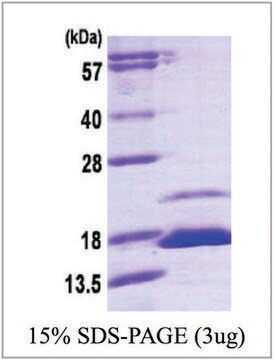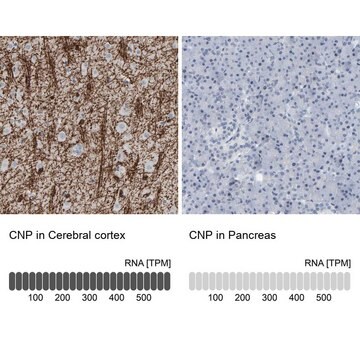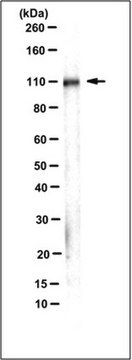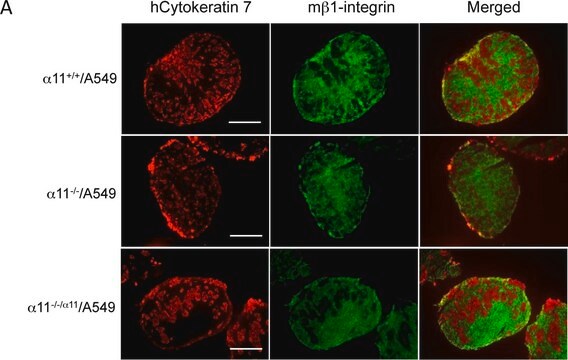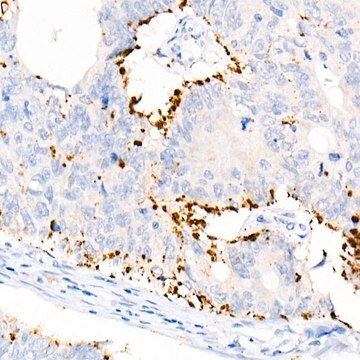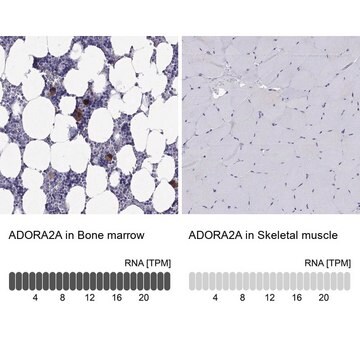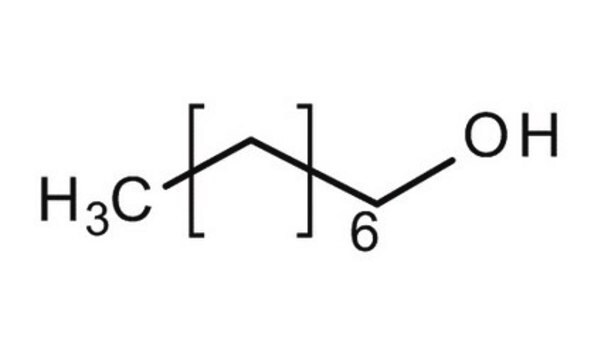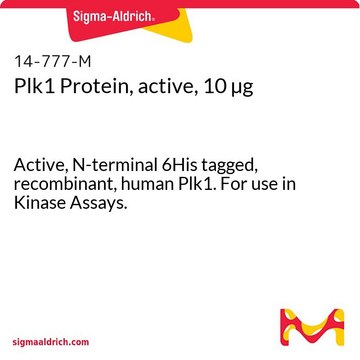SRP6063
PIN1 human
recombinant, expressed in E. coli, ≥95% (SDS-PAGE)
Sinónimos:
DOD, NIMA-interacting protein 1, PPIase Pin1, Rotamase Pin1, UBL5
Iniciar sesiónpara Ver la Fijación de precios por contrato y de la organización
About This Item
Productos recomendados
origen biológico
human
recombinante
expressed in E. coli
Análisis
≥95% (SDS-PAGE)
formulario
liquid
mol peso
18.2 kDa (163 aa)
envase
pkg of 100 μg
Nº de acceso NCBI
Condiciones de envío
dry ice
temp. de almacenamiento
−70°C
Información sobre el gen
human ... PIN1(5300)
Descripción general
PIN1 (peptidylprolyl cis/trans isomerase, NIMA-interacting 1) is a peptidyl prolyl cis-trans isomerase. It is a conserved eukaryotic protein that contains an amino-terminal WW domain, which functions as a phosphorylated serine or threonine residue-binding site. Its C-terminal domain functions as the enzymatic domain, and is responsible for catalyzing the cis/trans isomerization of pSer/Thr-Pro bonds.
Acciones bioquímicas o fisiológicas
PIN1 (peptidylprolyl cis/trans isomerase, NIMA (never in mitosis A)-interacting 1) associates specifically with the phosphoserine-proline or phosphothreonine-proline residues immediately preceding proline (pSer/Thr-Pro), and promotes cis/trans isomerization of the peptide bond. This protein is involved in the amplification of the phosphorylation signaling, and is involved in catalyzing target dephosphorylation, control of protein stability and ubiquitination. It also mediates the cellular localization of its target proteins. It is highly up-regulated in multiple types of cancers, such as breast and prostate cancer, and is essential for the functionality and cross-talk of tumorigenic pathways. It is also implicated in Alzheimer′s disease (AD) and asthma.
Forma física
1 mg/mL solution in 20 mM Tris-HCl buffer (pH 7.5) containing 100 mM NaCl, 5 mM DTT, 20% glycerol.
Nota de preparación
Centrifuge the vial prior to opening.
Otras notas
MADEEKLPPG WEKRMSRSSG RVYYFNHITN ASQWERPSGN SSSGGKNGQG EPARVRCSHL LVKHSQSRRP SSWRQEKITR TKEEALELIN GYIQKIKSGE EDFESLASQF SDCSSAKARG DLGAFSRGQM QKPFEDASFA LRTGEMSGPV FTDSGIHIIL RTE
Palabra de señalización
Warning
Frases de peligro
Consejos de prudencia
Clasificaciones de peligro
Eye Irrit. 2
Código de clase de almacenamiento
10 - Combustible liquids
Clase de riesgo para el agua (WGK)
WGK 3
Certificados de análisis (COA)
Busque Certificados de análisis (COA) introduciendo el número de lote del producto. Los números de lote se encuentran en la etiqueta del producto después de las palabras «Lot» o «Batch»
¿Ya tiene este producto?
Encuentre la documentación para los productos que ha comprado recientemente en la Biblioteca de documentos.
Guo-Liang Huang et al.
Cell death & disease, 7(12), e2571-e2571 (2016-12-30)
The function of activating transcription factor 1 (ATF1) and the mechanism about why ATF1 was over-phosphorylated in nasopharyngeal carcinoma (NPC) progression is completely undiscovered. In this study, a series of experiments both in vitro and in vivo were used to
Pin1 is related with clinical stage of papillary thyroid carcinoma.
Jiang L et al
World Journal of Surgical Oncology, 14, 95-95 (2016)
Peptidyl-Prolyl cis/trans Isomerase NIMA-Interacting 1 as a Therapeutic Target in Hepatocellular Carcinoma.
Kim G et al
Biological & Pharmaceutical Bulletin, 38(7), 975-979 (2015)
Pin1 induction in the fibrotic liver and its roles in TGF-β1 expression and Smad2/3 phosphorylation.
Jin Won Yang et al.
Journal of hepatology, 60(6), 1235-1241 (2014-02-18)
Therapeutic management of liver fibrosis remains an unsolved clinical problem. Hepatic accumulation of extracellular matrix, mainly collagen, is mediated by the production of transforming growth factor-β1 (TGF-β1) in stellate cells. Pin1, a peptidyl-prolyl isomerase, plays an important pathophysiological role in
Garam Kim et al.
Molecular carcinogenesis, 54(6), 440-448 (2013-11-23)
Pin1, a conserved eukaryotic Peptidyl-prolyl cis/trans isomerase, has profound effects on numerous key-signaling molecules, and its deregulation contributes to disease, particularly cancer. Although Pin1-mediated prolyl isomerization is an essential and novel regulatory mechanism for protein phosphorylation, little is known about
Nuestro equipo de científicos tiene experiencia en todas las áreas de investigación: Ciencias de la vida, Ciencia de los materiales, Síntesis química, Cromatografía, Analítica y muchas otras.
Póngase en contacto con el Servicio técnico